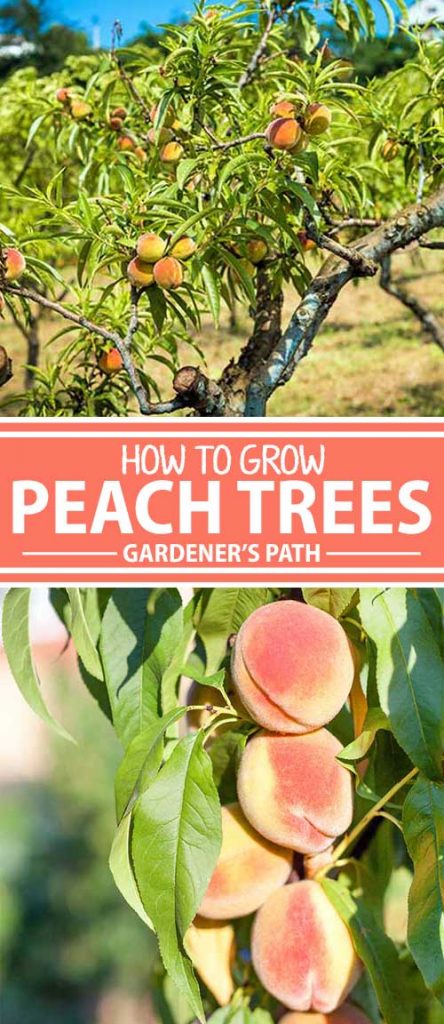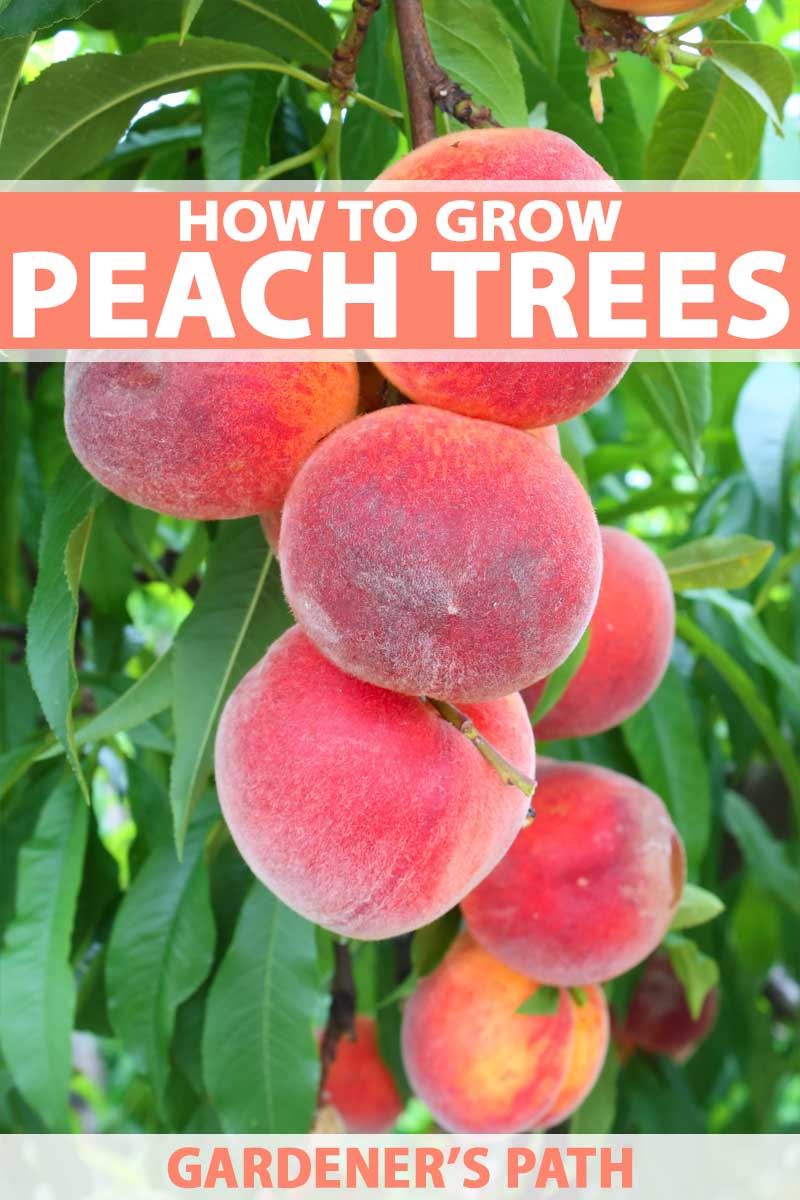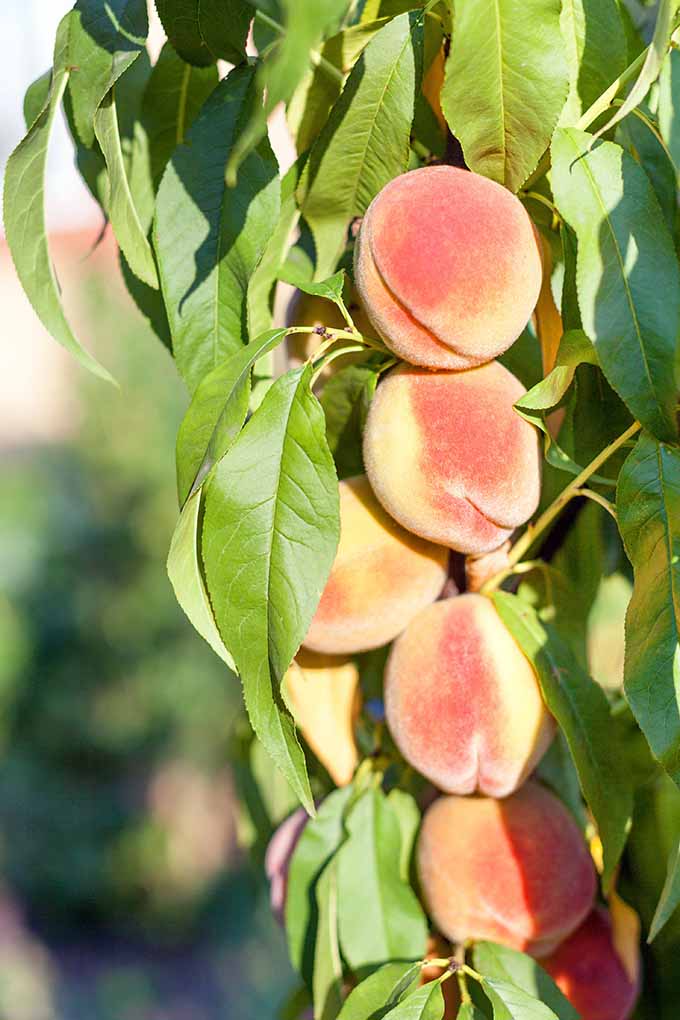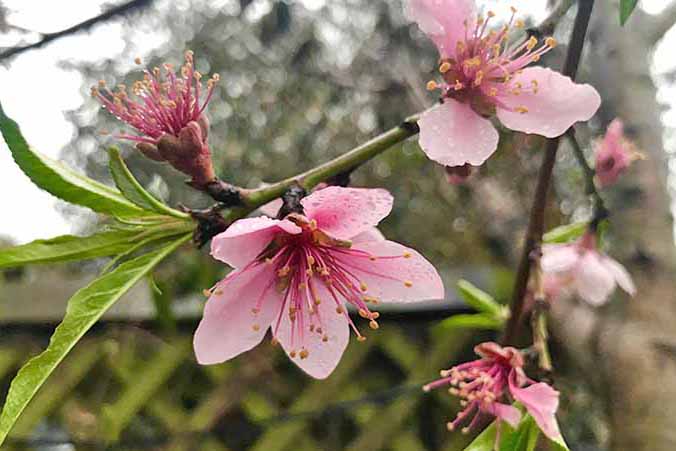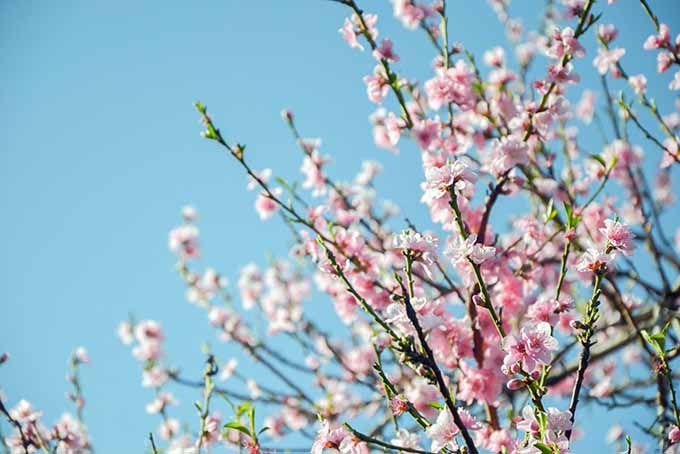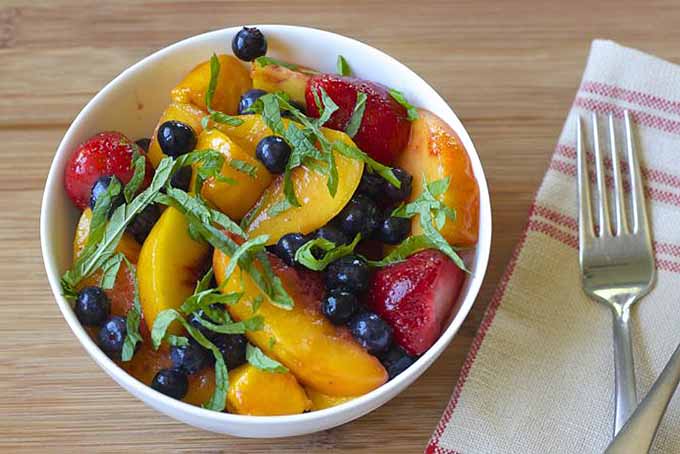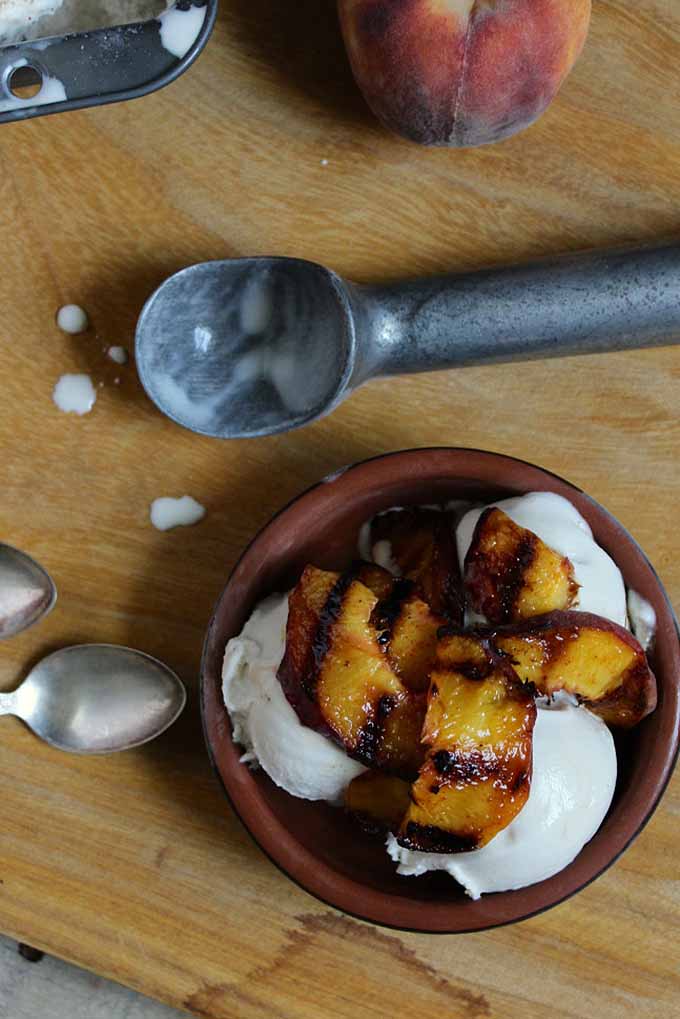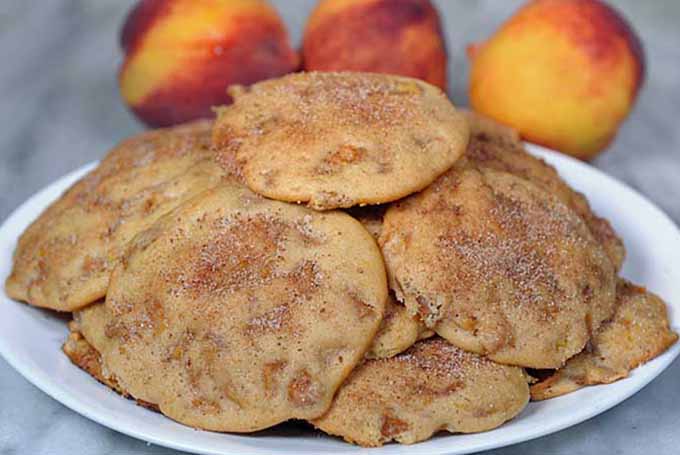How could we not oblige? And while that boy is coming up on his 18th birthday and the now-20-foot tree towers over his relatively tall 6-foot, 2-inch frame, he still enjoys its fruit each summer. In exchange for a home in our landscape, the sapling we planted has provided our family with bountiful crops almost every year (more on this in a minute), and we’ve enjoyed Reece cobbler, Reece pie, and Reece preserves — peach delights aplenty, all named for the boy who asked for a sapling as a birthday gift. We link to vendors to help you find relevant products. If you buy from one of our links, we may earn a commission.
Growing Requirements
Peaches will grow in zones 4 to 9, but do particularly well in zones 6 and 7. Varietal selection is particularly zone-dependant, and we’ll explore this more later in the article. These plants are self-pollinating, so while you may want to grow an orchard so that each of your children has his or her own tree, you don’t need more than one to get fruit.
The peach is a deciduous tree native to northwest China, and was brought to Florida by Spanish explorers in the 16th century. The tree’s delicate blossoms are heralded for their beauty and is similar to those produced by other close relatives (all in the Prunus genus), the fruiting cherries, flowering cherries, plums, nectarines, and almonds. The 1/2- to 1-inch flowers bloom in various shades of orange, red, pink, and violet, and can be quite fragrant. And while Georgia — the Atlanta area in particular — fancies itself the peach capital of the universe, California actually produces more of the fruit annually.
Which Tree to Choose and Where to Buy
It’s important to select a variety that is known to do well in your area. Peach trees have very specific chilling requirements in order to break dormancy and begin flowering. Each variety needs a certain number of chilling hours below a particular temperature. For example, ‘Bicentennial’ requires 750 hours under 45°F each winter in order to bloom, whereas ‘Gulfking’ needs only 350 hours under 45°F.
If you choose a cultivar that needs fewer hours of chilling than what commonly occurs in your area, your tree might start blooming during a January or February warm spell. And then a subsequent cold snap could kill all your blooms, meaning no peaches when harvest season rolls around. Sometimes, even if you have the right cultivar for your area, a late frost kills your blossoms anyway. Sadly, this has happened to us a few times. No Reece cobbler those years.
Growing from Seed: It’s the Pits
While you can grow a fruit-bearing tree from a peach pit, it probably won’t be the exact same type of peach that you originally ate to get the pit. As the product of pollen and ovules from potentially different sources, peaches will not necessarily grow true from seed. Contender Peach Tree Young saplings or more established trees will be 3-4 feet, 4-5 feet, or 5-6 feet tall and ready for spring planting. Check to make sure shipping is available in your area. O’Henry Freestone Peach Tree This variety needs 750 chilling hours, so it might be good for areas with moderate to pronounced winters. Purchase a plant from a reputable nursery or online source. Select a healthy, mid-size specimen that has an established root system. ‘Frost’ and ‘Avalon Pride’ can withstand cold weather, as can ‘Harken,’ which is available from Nature Hills Nursery.
Harken Peach Tree The nursery will ship you a 4- to 5-foot bare root plant that is hardy in zones 5-8. If you’d like a smaller variety that you can grow in a pot, look for ‘Pix-Zee’ or ‘Honey Babe,’ which grow to about 6 feet. Find ‘Honey Babe’ at Nature Hills Nursery.
Honey Babe Peach You’ll receive a 2- to 3-foot bare root plant that will produce fruit in three to five years. We grow ‘Sam Houston,’ developed at Texas A&M University specifically for Texas landscapes, with low chill-hour requirements. ‘Donut’ also does well in southern climes, requiring 400-500 hours of chilling. Find a 4- to 5-foot bareroot ‘Donut’ plant at Nature Hills Nursery.
Donut Peach Tree Experiments in hybridization and creating new varieties can be fun, though this requires a lot of patience while you wait for the plant to mature. Most commercially grown peach trees are grafted onto hardy and vigorous rootstock of related species, sometimes of dwarf varieties to contain the size of the new tree.
Where to Plant
If your child’s birthday is in October, give him an IOU until spring, because that’s when you’ll want to plant your sapling. Choose a sunny spot with deep, well-drained soil with a pH of around 6.5. Sandy loam or clay loam is best.
Dig a hole that’s a few inches deeper and wider than the root ball. Gently loosen the root ball and set it on a small mound of soil at the bottom of the hole, centering it in the hole. Carefully refill the hole with soil you removed, to the same depth of the container the plant came in. If you bury more of the trunk than what was buried when you bought the tree, the plant could die. Thoroughly water the newly planted sapling (this is a good job for the birthday boy/girl!).
Pruned or Not, Bountiful Still
Scatter one cup of 10-10-10 fertilizer at least 18 inches away from the trunk of newly planted trees. As the tree matures, feed it a 10-10-10 fertilizer twice a year — once in early spring and again in early summer, throughout its lifespan A peach tree needs about 36 inches of water annually. If you get frequent summer soakings — every ten days or so — you may not have to do supplemental waterings. If, on the other hand, you live in Austin, Texas, where it only rains once or twice during summer like we do, you’ll have to remind the birthday kid to bring out the hose.
If you were paying attention above, you probably noticed that I said our peach tree was 20 feet tall. That’s because we didn’t prune it. Many peach growers trim their trees to about 15 feet or less, producing a wider tree that makes it easier to reach the fruit. This is perfectly logical and a good thing to do if you’re not too busy raising three young boys who take all your time at the expense of properly pruning your peach tree! With our tall tree, we get out an 8-foot ladder to harvest the fruit we can reach, and let the squirrels and birds have the rest. It’s our form of giving back. Another important aspect of growing peaches is the need — however difficult it is — to thin the fruit when they are 3/4 to 1 inch in diameter. Pluck off excess fruit so that you are left with a fruit every 3 to 5 inches or more, depending on the variety. You’re going to feel like you’re removing a lot and it might be a shame to do such a thing. But trust me, you want your tree to devote its energy to growing the best harvest possible, rather than spreading its resources inadequately among far too many little fruits.
Propagation Problems: Some Fungi, Some Bugs
Harvesting
It’s picking time! Peaches are ready to harvest when: Prune for good air circulation if dampness is an issue where you live. Garden Safe Fungicide, 24 Fl. Oz. This 24-ounce bottle is ready to use. Depending on the size of your tree, you might need more than one bottle. Insect pests that sometimes plague this stone fruit include aphids, lygus bugs, thrips, scale, tent caterpillars, and stink bugs. Safer Brand Insect Killing Soap, 16-Oz. Concentrate This 6-ounce concentrated product will make up to 6 gallons. Learn more about proper pesticide application in our article about safe spraying.
They are soft There is no more green on the fruit They come off easily with a slight twist
The fruits at the top and around the outside of the tree usually ripen first. Be careful as you remove the fruit, as it bruises easily. We harvest our crop anywhere from late April to June, but timing will differ depending on your region and the cultivar you choose.
Recipe Ideas
The whole family — not just the birthday kid! — will enjoy treats whipped up with the gifts of your fruit tree. Though they’re great right off the tree, you’ll love these recipes as well.
Peaches & Cream(y) Burrata Toast
Let’s begin our peachy culinary tour with a tasty appetizer of cheese, prosciutto, and peaches. Just five ingredients come together for a sensational punch of flavor in this recipe from Hunger Thirst Play.
Fresh Peach Bellini
Not for the birthday kid, but perhaps nice for the parents to sip while the kids do the harvesting work, these refreshing drinks are sweetened with agave. Get the recipe from our friends at Wanderspice.
Frozen Fruit Salad with Mint
This family-friendly salad also features agave, and is a good way to use surplus peaches that you’ve frozen for long-term storage. The easy-to-make recipe comes from The Domestic Dietitian.
Spicy Pork Tacos with Peach and Corn Salsa
Peaches can be an important component of savory dishes as well as sweet, as you’ll find in these tasty tacos made with a pico de gallo-like salsa that stars stone fruit. Fresh parsley and mint are nice complements to the peaches. You’ll find the recipe at Foodal.
Baharat Black Eyed Peas with Broiled Peaches
This main dish includes baharat, a Middle Eastern spice mix that may include allspice, cloves, cumin, and nutmeg. Get the recipe at Kitchen Window Clovers.
3-Ingredient Coconut Ice Cream with Spicy Grilled Peaches
And now, as a reward for your patience, dessert. Let’s start with ice cream, because why not? The peaches in this recipe from The Fitchen are seasoned with bit of cayenne for a surprising kick.
Martha’s Peach Cookies
Adapted from a recipe by the queen of all things home and hearth, Martha Stewart, these treats are part cookie and part pastry, and packed with peach flavor. They’ll get a bit mushy if they sit for awhile, so it’s best to eat them right away… as if that were a chore, right? Get the recipe from our sister site, Foodal.
(End of Summer) Peach Blackberry Galette
Two summer fruits top a flaky, buttery crust in this mouthwatering sweet treat that includes bourbon vanilla powder. Find the recipe from Sugar Love Spices.
Summer’s Golden Orbs
Last year we had so many peaches, we shared them with half the neighborhood. Perhaps one of the children who enjoyed one of our fruits will ask for a peach tree for her birthday, and the cycle will continue.
Truly, the trickiest part of growing this plant is choosing the right cultivar. Get some help from local experts to select the perfect type for your area, make sure your tree gets sufficient water, and you’ll be swimming in peaches. Have a family birthday coming up? Get a fruit tree and and enjoy the gift that never stops giving. Perhaps you already have a peach in your yard? Tell us about it in the comments section below. If you’re hankering for another fruit tree, how about a fig? And if you’re looking for more ideas to get out in the garden with the kids, read this article to get started.

